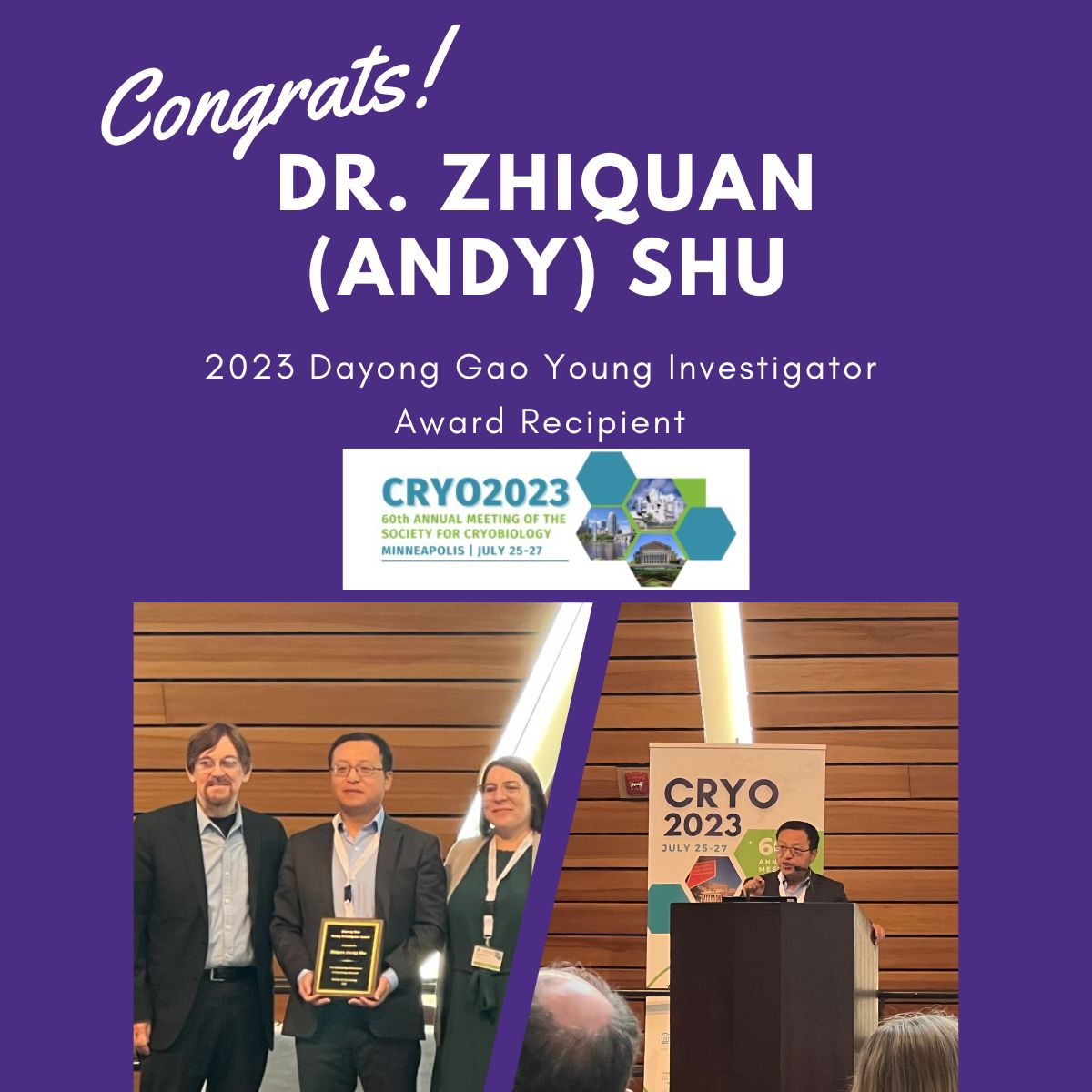Dr. Zhiquan (Andy) Shu wins award from the International Society for Cryobiology
Mechanical Engineering Professor Dr. Zhiquan (Andy) Shu Wins the "Dayong Gao Young Investigator Award" from the International Society for Cryobiology

The annual conference of the International Society for Cryobiology was just held in Minneapolis, Minnesota on July 25-27. During the meeting, it was announced that Dr. Zhiquan (Andy) Shu from the University of Washington Tacoma was awarded the prestigious “Dayong Gao Young Investigator Award” of the Year 2023. The ceremony was conducted after Dr. Shu’s plenary speech at the meeting on July 27th.
Dr. Shu is an Assistant Professor in the School of Engineering and Technology at UW Tacoma, the Associate Director of the Center for Cryo-biomedical Engineering and Artificial Organs, and an Affiliate Assistant Professor in the Department of Mechanical Engineering at UW Seattle. He has dedicated about 15 years to research in cryobiology and biopreservation, developing novel approaches, technologies, and devices for the cryopreservation of cells, tissues, and organs. His work has far-reaching applications in cellular therapy, tissue and organ transplantation, conservation of endangered species and biodiversity, fundamental biomedical research, and beyond.
The “Dayong Gao Young Investigator Award” is among the few most distinguished awards in the Society for Cryobiology. Established in 2019, this award is to recognize and celebrate excellence in research and academic impacts for the young investigators who are in the first 10 years of their post-PhD career and have been engaged in research related to cryobiology. The award is open to candidates from around the world, who do not need to be a member of the Society for Cryobiology. Every year, this award is presented to only one researcher. For more information about this award, please see https://www.societyforcryobiology.org/dayong-gao-young-investigator-award.
“I feel so honored to receive this young investigator award. This is not only an honor for me but also for all my team members, especially my Ph.D. and career mentor, Dr. Dayong Gao, and all the students I’ve worked with.” Dr. Shu said. “This also spurs me to work even harder in the future, applying my research outcomes to benefit people and societies.”
It’s noteworthy that this young investigator award is named after Dr. Dayong Gao, who is a professor at the Department of Mechanical Engineering at UW Seattle. Dr. Gao is a well-known worldwide scholar in cryopreservation. He was the President of the Society for Cryobiology in 2018-2019, and currently, he is the President-Elect of the International Society for Biological and Environmental Repositories (ISBER).
One example of Dr. Shu’s research impact: long-term organ preservation:
Approximately 730,000 annual deaths in the U.S are attributed to end-stage organ diseases and about 50,000 patients are added to the U.S. transplant waiting list annually. For certain organs, less than 10% of patients on the waiting list will receive transplantation [1]. Adding to the organ donor shortage, each year a large fraction of donor organs end up wasted due to the absence of long-term organ preservation technology. For example, 70% of donor hearts and 81% of donor lungs are eventually discarded. Maximum clinical organ preservation time limits are currently measured in hours by hypothermic storage (e.g., 4-8 ºC), varying according to the organ to be transplanted. This requires organs be transplanted immediately after donation, which causes an insurmountable barrier in organ matching, transportation, and transplantation. The development of technologies that substantially increase the availability of transplant organs would be analogous to curing cancers in terms of their lifesaving and life-improving impact and should therefore be prioritized as a top scientific endeavor. Some studies showed that with innovations in organ preservation technology that remove all supply constraints, the organ transplant waiting list could be cleared in several years, and organ replacement could prevent >30% of all deaths in the U.S. and double the average person’s likelihood of living to 80 years old [1]. In addition, advances in organ preservation could enable the long-term banking of organs with large organ pools, thus providing donor diversity and allowing sufficient time for organ screening, matching, and sharing. These innovations would particularly benefit those who have difficulty in finding matched donor organs, such as children, ethnic or demographic minorities, and other vulnerable patient populations who have markedly reduced access to transplantation.
However, organ cryopreservation, as the “holy grail” in cryobiology, is still an unsolved challenge due to the longstanding barriers, particularly in the rewarming step when organs are heated from the cold storage for transplantation. In this process, ultrafast and uniform rewarming is critical to avoid injuries to organs caused by ice recrystallization and thermal stress-induced fractures. However, none of the currently existing heating technologies can meet this goal. Dr. Shu and his team have developed a single-mode electromagnetic resonance (SMER) system, which achieves fast and uniform heating for large samples, and potentially can address the historic challenges in organ cryopreservation.
[1] Giwa, et al., The promise of organ and tissue preservation to transform medicine, Nature Biotechnology, 2017, 35(6): 530-542.



